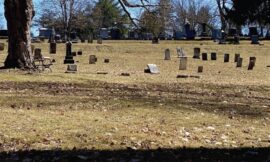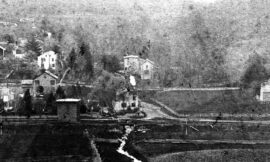Towns

AfAm Burials Rhinebeck
Below: The story of Andrew Frazier, the ancestor. The only Black family with a large plot. Adjacent to and facing, but not technically within, “Colored Section E.” Below: Images and profiles.
Posted in: African Heritage, For everyone, Towns

Moore’s Mills
Click any image to enlarge: The hamlet of Moore’s Mills is in the Town of LaGrange.
Posted in: Towns
Two Houses, One Political Divide
Two Rhinebeck Houses Reflect Opposing Political Views in 1860 By Bill Jeffway A study of two houses across the street from each other in Rhinebeck, and the politics of their owners, is a study in the politics of our early republic in the run-up to the Civil War and the split in the north within the Protestant White establishment. Their opposing involvement in the 1860 US Presidential election, and some local actions and words of Abraham Lincoln, offer insight into the divisions in the country, and Lincoln’s “team of rivals” approach to reconciliation. Although in 1860 Ambrose Wager was living north of Rhinebeck Village on Montgomery Street in a house that stands today (see photo), he is best known for his Second Empire house on West Market Street that was constructed in 1874. Slightly younger than Darling, Wager built the monumental West Market Street house at the peak of his life’s achievement, as was the case with Darling when he built his West Market street house in the 1850s. From Era of Good Feelings to Civil War in a Generation Local newspapers in Dutchess County, and around the country in 1817 were describing what they saw as an Era of Good Feelings in the country where political divisions were put aside. The name and concept took hold, and the era is seen by historians as aligned to the Presidency of James Monroe, from 1817 to 1825. But in little more than a generation, between 1861 and 1865, the Civil War caused the deaths of 2% of the US population, the equivalent of 7 million people today. Nathan Darling chose Hudson River Bracketed Style Nathan Darling had built the house that stands today on the north side of Market Street by 1858 in a classic, local style described as Hudson River Bracketed by the local architect of national influence Alexander Jackson Davis. It was a style designed by Davis that could be embraced and executed by the average working class, as well as the elite, and everyone in-between. Although never a political candidate, the 1860 Federal census description of his occupation as “politician” is appropriate given the path he took to become a “wide-awake” leader of the Republican party. Ambrose Wager chose Second Empire Style On the south side of West Market Street stands the home of Ambrose Wager, an imposing Second Empire style home reaching back to Napoleonic France for inspiration built in 1874. Its imposing grandeur and connotations of Empire give it an immovable feeling. Wager’s 1883 obituary describes him as a steadfast and unwavering “Democrat of the old school.” The Democratic Party of that time was associated with a more permissive approach to slavery and its expansion. Wager was the 1860 candidate for Congress for the Democrats. Darling was active in politics all his life. In that transitional period between the era of good feelings and the Civil War, he got involved in a wide array of political movements that splintered and coalesced and splintered and coalesced again. The names of the political movements at the time give us a sense: the Locofoco’s, the Hindoo party, the Barnburners, the Know Nothings, the Free-soilers, the Native American party (referring to European Americans born in this country), the Hard and Soft Democrats. That splintering started to recede as the newly formed Republican Party emerged in 1854, a party with anti-slavery sentiments. By the 1860 Presidential election the Republican party had matured and Lincoln emerged as the party leader. Going further, however, within this movement, there emerged locally and all across the north, the most visible agitators for Lincoln who became known as the Wide-Awakes. The name was meant to reflect the depth of their commitment, and the level of energy they brought to the cause. Given the nimbleness of Darling’s prior political maneuvers, it is not surprising he became the visible leader of that movement in northern Dutchess County. Here is a description of a Rhinebeck parade from the November 3, 1860 Poughkeepsie Daily Eagle, “Grand wide-awake demonstration at Rhinebeck. 1,300 men in line. The Republicans of Rhinebeck had a grand time last evening. The parade of the wide-awakes was far ahead of any political procession ever seen before in this town. The clubs from Poughkeepsie were on hand headed by Flockton cornet band and were honored with the right of the line. The procession formed under command of Captain Darling Grand Marshal. Almost every house in the village was illuminated in the enthusiasm of the spectators and was unbounded as a political demonstration. It was most successful and showed most conclusively that the Rhinebeck Republicans are wide-awake for the cause.” As the Republican candidate, Lincoln won the November 1860 Presidential election without winning any southern state. And while he won all northern states, except New Jersey, you need only look at Dutchess County election results to see the choice was far from a mandate in the North. While Lincoln carried the county overall, he did not carry East Fishkill, Fishkill (Beacon), Hyde Park, LaGrange, Red Hook, or the Town of Poughkeepsie. Lincoln won the electoral college with only 39% of the popular vote. Lincoln inaugural train stops in Rhinebeck This was the divisive backdrop to the inaugural train journey from his home in Springfield, Illinois to Washington DC where he would take the oath of office that included Lincoln, Mrs. Lincoln, their three sons, and Lincoln’s African American servant William Johnson. Lincoln had stopped in Albany overnight and was on the next leg of his trip when he stopped briefly in Rhinebeck. Lincoln is described by viewers as having bowed, but not spoken to the crowd. The New York Times reported that Lincoln picked up at least one person, specifically William Kelly, of Rhinebeck’s Ellerslie Estate. Kelly had just run for, and lost the NY Governorship candidate from in the Democratic Party. This kind of outreach is typical of Lincoln’s “team of rivals” embrace. Ambrose Wager was the (also failed) Democratic candidate for congress in the 1860 election.
Posted in: For everyone, Towns
Dutchess County’s Knickerbocker Trail
For a very long time, since 1809 to be precise, the best-known Knickerbockers have been the fictional characters depicted by the author Washington Irving in a satirical history of New York. His work spawned the use of the iconic name to mean a “real” New Yorker, the Dutch focus reflecting the fact that the first European settlers in New York were Dutch. The popularity of Irving’s work led to the popular depiction of the “Father Knickerbocker ” character, with a three pointed hat and knickerbockers, the pants that go just below the knee and socks take care of the rest. The name lives on popularly today in the basketball team, the New York Knicks, among others. Bryan Knickerbocker lives outside of Philadelphia, and has been studying his family history for decades. DCHS is pleased to be publishing Bryan’s findings in a less traditional way, through the serial publication of chapters that will illuminate points along a trail in northern and central Dutchess County. That evolving trail can be found at www.dchsny.org/knickerbocker-trail. Among the most extraordinary findings, 90% of the Knickerbocker’s in the United States are descendants of these northern Dutchess Knickerbockeers. Subsequent chapters will be told and assigned their place on the Knicerkbocker trail! Bill Jeffway To best view the trail, align your mouse over the trail window (middle) and scroll up and down. To adjust the position of the window, align your mouse to the left or right edges and scroll up or down.
Posted in: For everyone, Towns, Trails
Troutbeck
DCHS Yearbook Encore Editions: Troutbeck The Dutchess County Historical Society is pleased to continue a long and dynamic relationship with Troutbeck, starting at the time of our founding with Joel and Amy Spingarn. As a historic place of assembly, reflection, and creativity, DCHS is proud to continue to share the story of Troutbeck. Below you find some examples of DCHS publications and writings related to Troutbeck. Profile of Amy Spingarn NAACP Conferences Spingarn on Gardening Value of Local History DCHS’s Inaugural Monogram Below are slides from a short talk given by Bill Jeffway April 22, 2022 at Troutbeck that examine the importance of place, and the intersection and convergence of dynamic communities and worldviews first laid out and greatly influenced by its location “in between” New England and New York, and between New York City and “upstate.”
Posted in: For everyone, Towns
DCHS Bockee Smithfield July 16 2022
The Rich Mosaic of Rural Life in Early Dutchess County Revealed The public joined descendants of Amenia’s Bockee family (pronounced boh-KAY) at the historic Smithfield Church in Amenia on Saturday, July 16, 2022. The Dutchess County Historical Society (DCHS) and Amenia Historical Society (AHS) co-hosted the event since both organizations have important collections related to the family. Talks were given by DCHS and AHS Trustee Betsy Strauss, DCHS Collections Chair & Trustee Melodye Moore, and DCHS Executive Director, Bill Jeffway. The period of time examined ranged from the late 17th century, when the Bockee family first purchased 350 acres in the area in 1698 (they actually built a home and settled around 1761) through to the end of the Civil War, and into the mid 20th century. As talented, educated, community-oriented establishment figures with means, the family could have chosen to live in Poughkeepsie or New York City, and for certain periods of time, certain family members did. But essentially, over the centuries the family chose to live a rural life. Items from DCHS & Amenia Historical Society Collections That Were Featured at the Church Bockee School Silk Coverlet by Students Bockee Medical Chest Civil War
Posted in: DHCS Events, Towns
